Farming the land
Farming in Laxton is dominated by the open fields and their strict crop rotation. Individual strips are owned or occupied by separate farmers, who work the same strips each year. The open fields are worked in the same way now as they were in previous centuries, except that modern machinery is used in place of horses.
The strip is sown with winter wheat in the first year and with a cereal crop of the farmer’s choice in the second year. It is left fallow (not cultivated) in the third year. Commonly grown cereal crops are wheat, oats, barley, peas and beans. Crops which do not fit into this rotation can be grown in enclosed areas outside the open fields.
Grass is cut for hay in the early summer. The sykes (grassy areas in the open fields) are not sprayed with weedkiller or fertilizer and are designated as ‘unimproved grassland’. Traditional wildflowers grow there in the spring. The open fields in Laxton are part of a Countryside Stewardship agreement which helps to protect the landscape and encourage wildlife habitats.
Soil map from Robert Lowe, General view of the agriculture of the county of Nottingham (London: printed for G. Nicol: printed for Richard Phillips, c.1798)
From East Midlands Special Collection Not 1.P6 LOW
Laxton is on the ridge of Keuper Marl soil shown here in pink. This heavy clay soil is good for growing wheat.
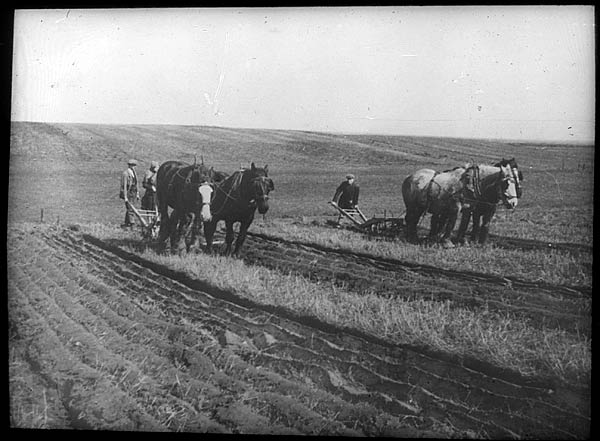
Photograph showing ploughing with horses at Laxton, c.1930s
From Ch Pa 178
The fields were ploughed in the autumn and winter after the previous year’s crops had been harvested. Mark Pierce’s 1635 map shows ploughs pulled by a pair of oxen and a leading horse, but by the twentieth century just horses were used. The farmer walked behind and made sure that the ploughing was straight and even.
"Ridge and furrow alike must be exactly straight – or else. Bad workmanship on the land was frankly despised, commented on with derision. Always it took two, three or four horses and a fore-horse to slice through Laxton’s particularly deep and solid clay."
Edith Hickson, Life at Laxton c1880-1903: The childhood memories of Edith Hickson (Nottingham: Dept. of Adult Education, The University of Nottingham, c.1983) East Midlands Collection Pamphlet Not 254.D28 HIC. p.11
The complete grazier and farmers’ and cattle-breeders’ assistant, by William Youatt, re-written by William Fream (London: Crosby Lockwood and Son, 1893)
Special Collection S511.C6
This popular compendium on farming went into numerous editions. Shown here are pages relating to ploughs and furrows. Both swing and wheel ploughs were used in Laxton in the late nineteenth century. The coulter at the front of the plough cuts through the upper layer of the soil, and the curved mouldboard pushes it over to the right so that it lies half on top of the previously ploughed furrow. New soil is exposed and weeds are buried.
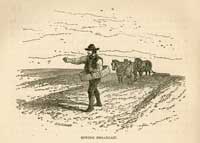
Broadcast sowing, from G.H. Andrews, Modern Husbandry
(London: Nathaniel Cooke, 1853), p.244
From Special Collection S513.A6
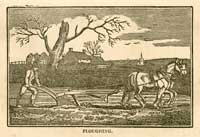
Illustration of ploughing from A Picture of the seasons
(London: printed for W. Wetton, sold by C.F. Cock, 1831)
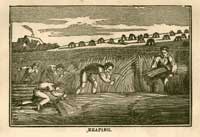
Illustration of reaping from A Picture of the seasons
From Briggs Collection LT210.S/P4
Although the mechanical seed drill was invented in the early eighteenth century, sowing by hand from a bag remained a popular way of distributing seed. In the background another farmer can be seen, preparing to bring a harrow across the soil to cover the seeds.
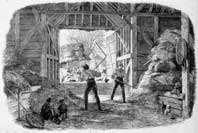
Photographic copy of an engraving of a threshing barn, 19th century
From MS 823/1/4/39
Traditionally, grains of wheat or corn were loosened from their husks by beating them by hand with a flail (threshing). Threshing was carried out on the floor of barns where the grain was stored. Winnowing separated the grain from the waste chaff. The threshing barn had opposing doors which could be partially closed in order to create a draught to carry away the chaff. Steam-powered threshing machines were introduced in the late nineteenth century.
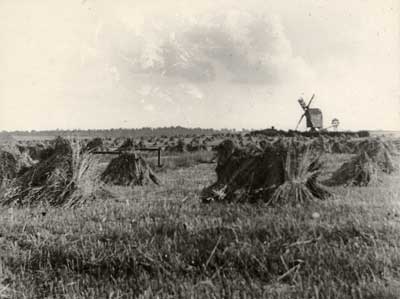
Copy photograph of Laxton Mill, c.1914 MS 829/2
Laxton’s windmill, situated in Mill Field, is shown on Mark Pierce’s 1635 map. It was blown down in 1916 and not replaced. The photograph was taken at harvest time. Sheaves of the harvested cereal are arranged into ‘stooks’ to dry for a few days before being taken to be threshed.
More: Livestock and Dairy Farming
Laxton: Farming in an Open Field Village home